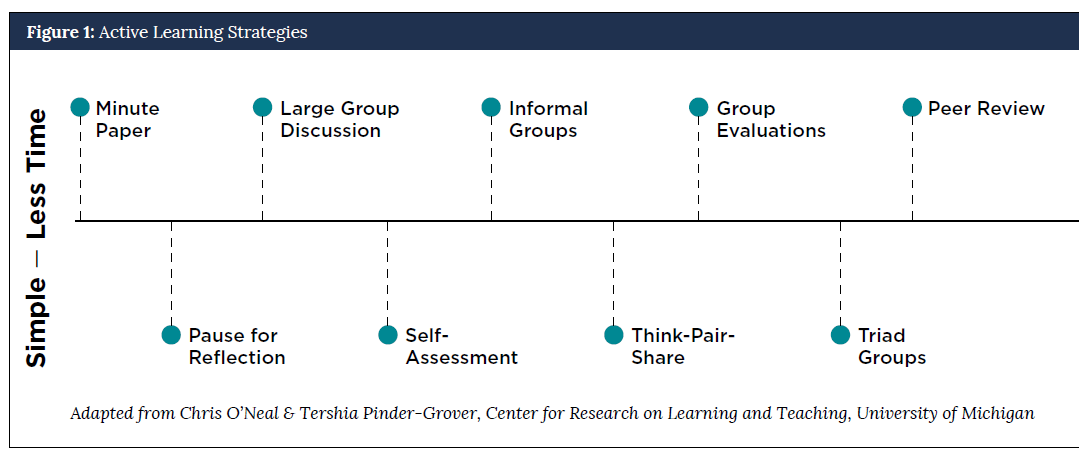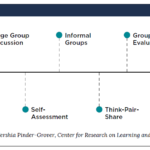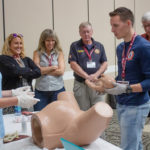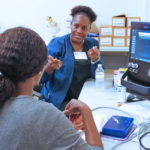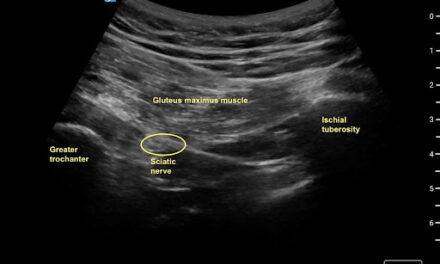Education Corner: Let’s Get Active! Active Learning in Medical Education
As educators, each of us recognizes that maintaining learners’ engagement during a presentation can be challenging. We know how to use a traditional teaching model to deliver new information by using passive didactic lectures, but we also know that it may not always be the best way to get the information across. This is the moment when we reach for active learning tactics as an educator. This article defines active learning, discusses the evidence and learning theory behind it, and briefly summarizes different active learning strategies that medical educators can adopt to improve learner engagement.
Malcolm Knowles emphasizes that it is through watching, exploring and studying behavior that adults begin to learn. In other words, when the learner is more than a passive recipient of the information and has active involvement, the information is integrated at a higher level of cognition. Traditional teaching models consist of a long lecture format. The educator delivers the information, and the student passively listens with minimal critical thinking skills being used and little engagement of the learners. Adult learners have an attention span of 15 to 20 minutes; therefore, they may be considered ineffective if lectures are longer than this. In contrast, active learning is recognized as a learner-centered approach in which information is presented in a way that engages, motivates, promotes discussion and uses critical thinking skills. Learners are required to partake in purposeful learning activities and ponder on the things they are involved in.
Active learning is based on the theory of human constructivism, which states that knowledge is built rather than passively acquired. Active learning has four main components: triggering prior knowledge, including student participation, encouraging student metacognition and delivering feedback about student’s learning. Scaffolding is the process in which teachers build upon prior learning and, through progressive learning, add layers of complexity to the topics which promote independent learning. Building this takes critical thinking and reasoning skills and allows students to further assimilate new knowledge, adding to existing knowledge and skills. Although each individual teaching strategy has a specific learning theory at its root for existence, the overarching components are exemplified.
Active learning does not necessarily mean altogether abandoning the lecture format, but incorporating a range of different activities. Integrating opportunities for engagement will aid in the retention of information, thereby promoting a higher level of cognition. As a result, engaged learners are more likely to look for other opportunities to learn beyond the classroom setting. Active learning strategies range from simple activities such as pausing for reflection or large group discussion, to simulation and experiential learning. In preparation and planning for including these strategies, the educator must consider the timing of the strategy. Some strategies will take more time than others. Figure 1 shows the continuum of some active learning strategies arranged by complexity and time commitment.

In practice, incorporating active learning into didactic teaching should be considered when possible. It must be well thought and aligned with the desired learning outcome. For example, if you wish to discuss communication skills, creating a role-play scenario may be helpful. Next, you should gauge your learner’s level of knowledge on the topic and the amount of time allotted for your session. Some basic concepts may need to be taught or reviewed before gaining additional knowledge. If you have an extended period of time, you can teach first then incorporate active learning. In contrast, assigning the learners to review key concepts by using reading or asynchronous activities may be more beneficial for a short period of time. The planned learning session can be focused on an active strategy during your allotted time.
Implementing active learning strategies can be challenging. Learners might be reluctant to participate in active learning activities. But explaining to them the purpose and value of the strategy has shown to decrease resistance. Last, do not be afraid of trial and error – inevitably, there will be a learning activity that goes well and those that do not. Keep trying as you perfect your active teaching skills.
Active learning in medical education can be achieved through many different techniques and teaching practices. Employing active learning is beneficial for both the learner and the educator. It immerses the learners in the process through writing, reading and discussions. It results in improving knowledge retention, creates a deeper understanding, and encourages self-directed learning. Therefore, it promotes the development of critical thinking and an analytical approach to problem-solving. However, understanding these concepts is just the beginning. Striving for active learning as an educator is a lofty goal that takes time, patience and persistence, but its benefits to the learners outweigh this strife. The challenge for each of us is to try something new the next time you teach. ■
References:
Prince, M. (2004), Does Active Learning Work? A Review of the Research. Journal of Engineering Education, 93: 223-231.
Torralba, K. D., & Doo, L. (2020). Active Learning Strategies to Improve Progression from Knowledge to Action. Rheumatic diseases clinics of North America, 46(1), 1–19.
Yang, C. (2021). Active Learning: Techniques to Improve Learner Engagement. Accessed August 27, 2021.
Wolff, M., Wagner, M. J., Poznanski, S., Schiller, J., & Santen, S. (2015). Not another boring lecture: engaging learners with active learning techniques. The Journal of emergency medicine, 48(1), 85–93.
Center for Research on Learning and Teaching. (n.d.). Introduction to Active Learning. Accessed August 27, 2021.
This article is part of the following sections:

